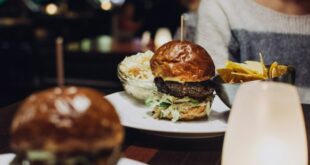An Giang Province, which borders Cambodia in the upper Mekong Delta, has become famous for a beef dish that is more a neighborly fusion than a Vietnamese original.
Bo leo nui – which translates to “mountain climbing cow”– is not actually cooked from cattle that live in the mountains, even though many fans of the dish still misconstrue it this way.
The only reason the name has anything to do with a mountain is because the skillet used to cook it is raised in the center, forming a little “mountain.”
The dish originated in Cambodia. But locals in An Giang’s Tan Chau district have not only mastered the concoction, they have now customized it and made it into one of the Mekong province’s unique specialty meals.
At local bo leo nui restaurants, diners sit at tables outfitted with a grill and “mountain” skillet so they can watch chefs cook the food live and in person. Raw ingredients like thickly sliced marinated beef and seasonal vegetables are placed in front of patrons before cooking. Two raw eggs are cracked into the middle of the beef pile to soften the meat and bring out more of its fatty taste and hidden flavors.
 |
|
The skillet’s central grill is shaped like a mountain. Photo by VnExpress/My Nhung |
To start cooking the dish, a thick piece of pork fat is placed at the top of the mountain skillet to let the melting fat spread itself all over the skillet. Then the raw beef is arranged around the fat to cook in the pork grease. As the fat continues to melt slowly over the charcoal stove, it drips and drizzles over the beef, which makes the already rich meat even more savory.
This unique skillet has deep sides surrounding the mountain like a moat. This is where the cook then pours in some beef bone broth. While waiting for the meat to cook, diners can dip vegetables and other foods into the soup.
It’s like eating grilled beef and hot pot at the same time. Locals from An Giang call it: “two-in-one eating.”
A portion of bo leo nui at An Giang specialty eateries costs between VND100,000 to VND200,000 ($4.22 to $8.44), depending on how much meat you order and how many diners sit at your table. The dish also comes with rice paper, herbs and dipping sauce. Each restaurant has their own sauce recipe.
Mam bo hoc or Prahok, a fermented fish paste commonly used in Khmer and Cambodian cuisine, is frequently served with the food.
 |
|
Diners can savor both grilled meat and hot pot at the same time with a mountain skillet of bo leo nui in An Giang. Photo by VnExpress/ My Nhung |
According to My Nhung, the owner of a bo leo nui restaurant in Tay Giang Town, her eatery is especially popular on chilly evenings or on rainy days when everyone wants both hot soup and fresh grilled meat proteins to warm up.
During the peak months of June to October, Nhung’s restaurant serves up nearly 100 portions of bo leo nui every evening. Many of the diners are curious travelers who have come from as far as Ho Chi Minh City, Can Tho, and Dong Thap. But rather than catering to tourists and raising her prices, Nhung’s genuine food remains inexpensive and authentic enough to attract crowds of regulars, local fans and families.
Bo leo nui has become so popular it can now be found outside An Giang in neighboring Dong Thap Province localities such as Sa Dec and Cao Lanh Towns.
- Reduce Hair Loss with PURA D’OR Gold Label Shampoo
- Castor Oil Has Made a “Huge” Difference With Hair and Brow Growth
- Excessive hair loss in men: Signs of illness that cannot be subjective
- Dịch Vụ SEO Website ở Los Angeles, CA: đưa trang web doanh nghiệp bạn lên top Google
- Nails Salon Sierra Madre
 VnExpress News The News Gateway of Vietnam
VnExpress News The News Gateway of Vietnam





